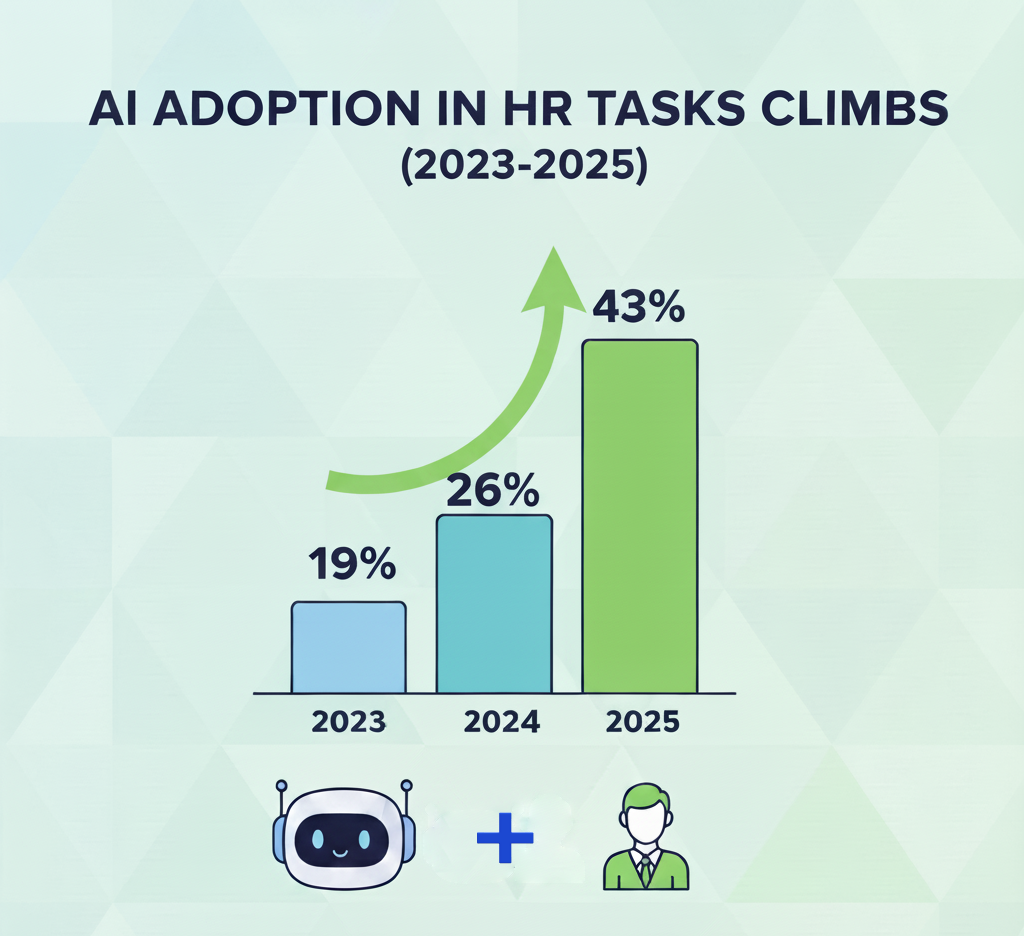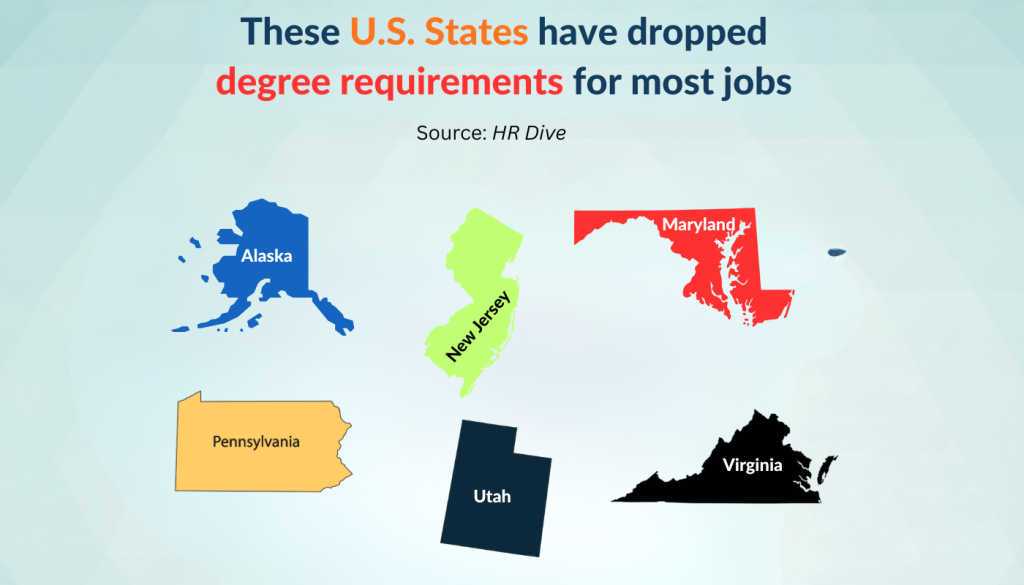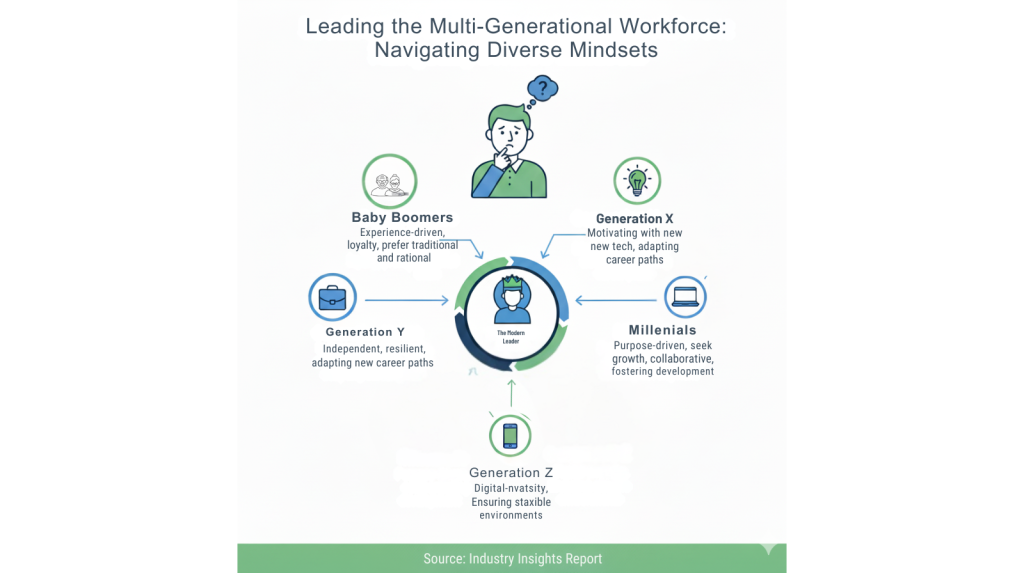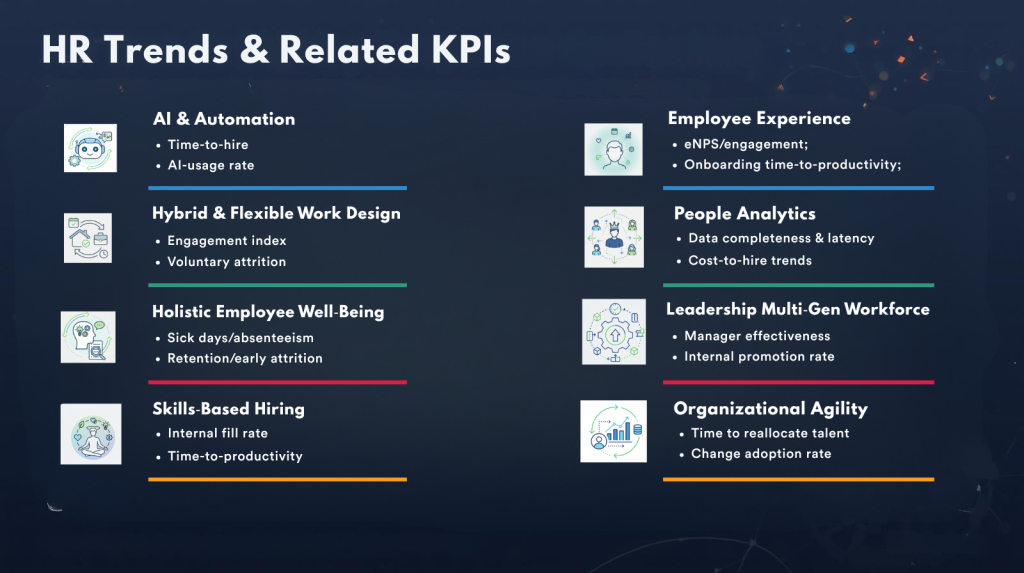As we come close to rounding off 2025, you can already see prevailing HR trends making their way into 2026. From AI Inclusion to hybrid work culture and adapting strategies for multigenerational employees, HR practitioners must learn and adopt the new trends. Or, completely fall behind!
But what are those trends, and how will those shape how HR professionals function?
To understand them, we need to look at stats and initiatives that made an impact in 2025 and a few years before. Let’s learn about the trends and their impact.
Quick Overview
The HR industry will see emerging trends making greater impacts on their daily operations in 2026. These trends are:
1 AI Agents & Automation
2 Hybrid & Flexible Work
3 Skills-Based Roles & Hiring
4 Holistic Employee Well-being
5 Hyper-Personalization of the Employee Experience
6 Leadership Development for a Multi-Gen Workforce
7 Organizational Agility & Change Readiness
8 People Analytics
You will face different challenges when adopting these trends. However, with proper planning and the right resources, you can perform optimally, despite the changing trends.
AI Agents & Automation
Going into 2026, organizations will rapidly adopt AI-driven tools for recruiting, talent management, and more. In fact, AI adoption in HR tasks climbed to 43% in 2025, up from just 26% in 2024, indicating a massive leap in one year.
AI agents will perform core HR functions, managing entire processes like:
- sourcing and scheduling high-volume candidates,
- deploying personalized onboarding journeys for an employee’s role and region,
- and providing instant resolution for first-tier benefits and policy queries.
This marks a transition from AI as a tool to AI as a digital team member. Managers and senior executives in financial, consulting, healthcare, and tech industries are already using AI for HR work. And the trend will only increase many folds going into 2026.

Generative AI and large language models are also making waves in daily work. A recent McKinsey study found that 75% of employees are already using generative AI tools in their jobs. Plus, 79% say it has improved their work performance.
Though this sentiment is fueling investment and exploration, bias and explainability, data privacy, uneven literacy, and unclear use cases are hampering broader rollout, as reported by Business Insider. To tackle this, you need to develop AI acceptable-use policies. Start with low-risk cases (JD and policy drafting, scheduling, HR knowledge bots), and mandate human-in-the-loop reviews and bias tests.
Hybrid & Flexible Work
2026 will be the year of hybrid work by design. Employees have grown accustomed to flexibility, and companies are adapting offices and policies accordingly. Surveys show an overwhelming 98% of workers desire remote work options, primarily for better work-life balance.
By 2026, the focus will have shifted decisively toward intentional design. This involves a multi-faceted strategy with:
- transforming physical offices into “smart buildings” engineered for collaboration,
- equipping leaders with the specific skills needed for virtual management, and
- implementing an efficient technology stack that bridges the experiential gap between on-site and remote employees.
The concept of “phygital” workplaces (blending physical and digital experiences) has emerged, acknowledging that even in-office work now leverages digital tools heavily. In fact, Gartner predicts that by 2026, 70% of workplace experiences will be orchestrated through collaboration platforms like Teams, Slack, and other digital hubs.
But challenges like clarity on eligibility, meeting overload, equitable visibility, and culture building across locations can occur. To tackle these,
- codify hybrid rules,
- train managers for outcomes
- async work, track engagement and attrition by location, and
- redesign offices as collaboration hubs.
Forward-thinking companies are also redesigning office spaces to serve as collaboration hubs that bring the off-site vibe on-site. Knowledge-work hubs across North America continue hybrid at scale, though city-by-city patterns
Skills-Based Roles & Hiring
Organizations are increasingly valuing what candidates can do over what degrees or titles they hold. Skills-based hiring, emphasizing practical skills, competencies, and potential, is growing.
Nearly 45% of companies intend to eliminate bachelor’s degree requirements for some positions by 2025. Furthermore, around 80% employers say they are likely to favor a candidate’s work experience and skills over education in their hiring decisions.

This shift means you need to create job descriptions focused on skills, using tools to assess candidate skills directly, and partnering with hiring managers to update mindsets.
In the future, skills data will feed strategic planning and AI-driven career paths; degree-free pathways will expand but require robust assessment to scale.
Employers are responding by launching “learning academies,” partnering with online course providers, and encouraging a culture of continuous upskilling. LinkedIn’s Workplace Learning Report found 94% of employees say they would stay at a company longer if it invested in their learning and development, highlighting how upskilling is also a retention strategy.
Holistic Employee Well-being
The most successful organizations by 2026 will follow a model of holistic well-being that addresses the “whole person”. This approach goes beyond physical health to include mental and emotional health, financial security, and social connection.
Recognizing that these elements are interconnected and essential drivers of productivity and engagement. 64% of employers view well-being as a top lever to increase talent availability, per WEF’s 2025 employer survey.
Taking care of employees has become a competitive advantage in hiring. It’s also a response to worker demand. Large and mid-market employers are expanding benefits (EAPs, financial wellness, flexibility) to compete on employee value proposition (EVP). And the trend is continuously increasing.
Trends show that employee well-being and wellness programs will compete with pay as a driver of mobility. And also have a say in retention and employer brand.
Hyper-Personalization of the Employee Experience
Companies are investing heavily in the employee experience (EX), and the trend will not stop anytime soon! A human-centric work culture is emerging as a key trend, emphasizing meaningful work, strong company values, and a positive environment for employees.
Recognition and EX improvements correlate with stronger engagement and business outcomes. When employees feel valued and empowered, they are more motivated and perform better. That’s why more firms are rebranding HR to “People/EX,” professionals, adding continuous listening and integrated recognition.
Real-life Example:
Companies have attendance and leave policies. Employees are expected to come and leave on time. Except for certain times of the year when employees may be required to work overtime. In such cases, they are given paid overtime.
However, I have seen a few employees receive the benefit of arriving much later than the stipulated office timing (an hour so later). Despite of that, management ignores their late arrivals and does not ‘punish’ or take actions against their regular late arrivals.
The reason? One of the employee has an ill mother he has to take care of, so he has to get out of home late. But his skill is extremely valuable to the company. A ‘verbal agreement‘ has been made in this case.
Another employee had the cause of arriving from a location that is extremely distant from office. It takes him at least 2 hours to arrive in office. Thus, his frequent 10-15 mins late attendances are ignored. Though, he has been informed about giving his best to arrive on time.
Hyper-personalization of EX is going beyond broad-based employee engagement programs. Here, you need to analyze and use data, AI, and tech tools to deliver individualized, context-aware experiences at every stage of an employee lifecycle.
Another aspect of this trend is the rise of People Experience teams or roles. Some organizations are rebranding HR or creating dedicated Employee Experience departments. They look holistically at the moments that matter to employees (onboarding, career milestones, performance reviews, etc.) and how to make those moments more engaging and positive.
Possible hurdles? Fragmented tooling, survey fatigue, and limited analytics maturity to target interventions. Implement instant and lifecycle feedback, modern recognition with values, and experience metrics related retention and performance to overcome the blockers.
Leadership Development for a Multi-Gen Workforce
Many organizations are facing a change in leadership as we enter 2026. Baby Boomers and Generation X are giving way to Millennials in leadership roles. In fact, the majority of Baby Boomers are retiring. Moreover, Gen Z employees are making up the majority of the workforce, adding different ways of thinking and workstyles.
Because leader and manager development was cited as the top HR priority for 2025 by Gartner’s global survey of HR leaders, this multi-generational leadership mix requires new approaches. Each group may have different skill gaps and expectations.
For instance, Millennial managers often seek more coaching and purpose-driven leadership, while older leaders may be adapting to managing remote teams for the first time. Large organizations have started to formalize manager enablement and modular leadership pathways.

Leadership styles must feature agility, empathy, and adaptability, balancing innovation with operational discipline. A Forbes insight suggests that great leaders in 2026 will need to be “ambidextrous”, able to foster bold innovation while executing with discipline in an uncertain environment.
Organizational Agility & Change Readiness
Organizations need to be more agile and change-ready than ever before. As McKinsey reports, most HR teams still plan short term; only ~12% of U.S. HR leaders do strategic workforce planning with a ≥3-year horizon, creating risk in a volatile skills era. So, HR’s role is expanding from policy administrator to change champion and organizational architect.
Upcoming years demand what some experts call organizational plasticity, meaning the ability of a company to rapidly adapt its structure and processes in response to change. You, as an HR person, are at the center of this, leading change management initiatives and helping shape flexible organizational structures.
There will be change fatigue, fragmented data, and situations where many teams conflate headcount with strategy. When these obstacles occur, run quarterly workforce planning cycles tied to business scenarios. Also, spin up an internal gigs marketplace and retire redundant processes.
One aspect is the breakdown of traditional hierarchies into more project-based, networked teams. HR works with internal talent marketplaces to deploy skills quickly where needed.
Agile, skills-aware organizations will reallocate talent faster and weather disruption better; HR’s remit expands from policy to product (experience + data + platforms). The dimension of agility here is how HR itself is organized and operates. The use of HR shared services and centers of excellence is increasing to improve operations. And continue to do in the coming days.
People Analytics
Use of advanced analytics, powered by AI, will become standard practice for modeling future workforce needs, predicting employee attrition risks, identifying specific work-related behaviors, and matching skills with job performance. This helps organizations move beyond intuition and make data-driven talent strategies.
As per Mercer, improving HR and People Analytics capabilities is now a top-ten priority for 46% of companies globally, showing a significant investment in both technology and talent for these teams.
A key application of this trend is in talent retention. AI-powered predictive attrition models can analyze a wide range of data points, like declining task completion rates or changes in communication patterns. These identify early signs of disengagement, allowing HR and managers to make proactive interventions before a valued employee resigns.
Comparison with Previous Years (2025 and Prior)
Many of the above trends have their roots in shifts that began earlier in the decade, but the difference heading into 2026 is the acceleration and maturity of these trends. For context, just a few years ago, in the early 2020s, remote work and AI in HR were relatively new or confined to certain sectors.
The pandemic in 2020 acted as a catalyst for remote/hybrid work and also put employee well-being in the spotlight. By 2022-2023, companies were experimenting with hybrid arrangements; now, in 2025, hybrid is an established norm, with 67% of employers offering it.
Similarly, AI has moved from pilot projects to being part of the HR toolkit. AI adoption jumped from 26% in 2024 to 43% in 2025. Generative AI’s mainstream emergence in late 2022 (with tools like ChatGPT) quickly influenced HR by 2023-2024. Prior to that, AI in HR was mostly algorithms in ATS systems and some gamified talent acquisition systems.
Key KPIs of the Trends
Take a look at the major KPIs of the trends that HR professionals will need to track to get the best results and insights.

FAQs
Will AI replace HR jobs?
Unlikely. AI will automate repetitive tasks (screening, scheduling, knowledge lookup) and augment HR professionals. The value shifts to human judgment: workforce strategy, change leadership, coaching, and ethical governance. Plan for reskilling, not replacement.
How should SMBs approach HR tech in 2026
Consolidate to a few interoperable platforms (HRIS + ATS + LMS/EX), prioritize embedded analytics and AI guardrails, choose vendors with open APIs, and negotiate usage-based pricing. Start with must-have workflows and expand as adoption grows.
How can we use generative AI in HR safely?
Adopt an AI policy (acceptable use, data retention, human-in-the-loop), vet vendors for bias/privacy controls, restrict sensitive data, train users, and audit outputs. Start with low-risk cases (drafting JDs, FAQs, learning content) before high-stakes decisions.
How do we shift to skills-based hiring?
Rewrite job descriptions around outcomes and must-have competencies, drop degree requirements where feasible, implement validated skill assessments, tag roles to a skills taxonomy, and enable internal talent marketplaces so employees can move across projects.
What metrics prove hybrid work is working?
Track engagement, voluntary attrition, time-to-productivity, manager 1:1 cadence, collaboration load, meeting quality, and role-appropriate productivity (e.g., cycle time, deal velocity). Pair quantitative data with pulse feedback by team and location.
Summing Up
The trends mentioned above will shape the HR domain in 2026 and beyond. These trends together will affect how we think about work, talent management, HR practices, and value creation.
The maturation of agentic AI, the shrewdness of emotionally intelligent leaders, skills-based talent models, a strategic focus on holistic employee well-being, the hyper-personalization of the employee experiences, advanced people analytics, and the hybrid work mode, all will come into play for a more changing HR industry, adaptable and fast-paced



Leave a Reply